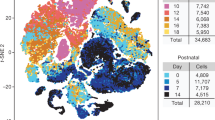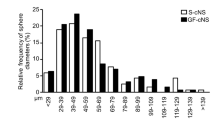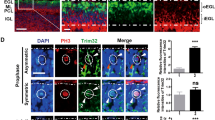Abstract
Cerebellar granule neurons are the most abundant neurons in the brain, and a critical element of the circuitry that controls motor coordination and learning. In addition, granule neuron precursors (GNPs) are thought to represent cells of origin for medulloblastoma, the most common malignant brain tumor in children. Thus, understanding the signals that control the growth and differentiation of these cells has important implications for neurobiology and neurooncology. Our previous studies have shown that proliferation of GNPs is regulated by Sonic hedgehog (Shh), and that aberrant activation of the Shh pathway can lead to medulloblastoma. Moreover, we have demonstrated that Shh-dependent proliferation of GNPs and medulloblastoma cells can be blocked by basic fibroblast growth factor (bFGF). But while the mitogenic effects of Shh signaling have been confirmed in vivo, the inhibitory effects of bFGF have primarily been studied in culture. Here, we demonstrate that mice lacking FGF signaling in GNPs exhibit no discernable changes in GNP proliferation or differentiation. In contrast, activation of FGF signaling has a potent effect on tumor growth: treatment of medulloblastoma cells with bFGF prevents them from forming tumors following transplantation, and inoculation of tumor-bearing mice with bFGF markedly inhibits tumor growth in vivo. These results suggest that activators of FGF signaling may be useful for targeting medulloblastoma and other Shh-dependent tumors.
This is a preview of subscription content, access via your institution
Access options
Subscribe to this journal
Receive 50 print issues and online access
$259.00 per year
only $5.18 per issue
Buy this article
- Purchase on Springer Link
- Instant access to full article PDF
Prices may be subject to local taxes which are calculated during checkout





Similar content being viewed by others
References
Kofuji P, Hofer M, Millen KJ, Millonig JH, Davidson N, Lester HA et al. Functional analysis of the weaver mutant GIRK2 K+ channel and rescue of weaver granule cells. Neuron 1996; 16: 941–952.
Hamre KM, Goldowitz D . meander tail acts intrinsic to granule cell precursors to disrupt cerebellar development: analysis of meander tail chimeric mice. Development 1997; 124: 4201–4212.
Mullen RJ, Hamre KM, Goldowitz D . Cerebellar mutant mice and chimeras revisited. Perspect Dev Neurobiol 1997; 5: 43–55.
Pascual-Castroviejo I, Gutierrez M, Morales C, Gonzalez-Mediero I, Martinez-Bermejo A, Pascual-Pascual SI . Primary degeneration of the granular layer of the cerebellum. A study of 14 patients and review of the literature. Neuropediatrics 1994; 25: 183–190.
Schuller U, Heine VM, Mao J, Kho AT, Dillon AK, Han YG et al. Acquisition of granule neuron precursor identity is a critical determinant of progenitor cell competence to form Shh-induced medulloblastoma. Cancer Cell 2008; 14: 123–134.
Yang ZJ, Ellis T, Markant SL, Read TA, Kessler JD, Bourboulas M et al. Medulloblastoma can be initiated by deletion of Patched in lineage-restricted progenitors or stem cells. Cancer Cell 2008; 14: 135–145.
Goldowitz D, Hamre K . The cells and molecules that make a cerebellum. Trends Neurosci 1998; 21: 375–382.
Wang VY, Zoghbi HY . Genetic regulation of cerebellar development. Nat Rev Neurosci 2001; 2: 484–491.
Fujita S, Shimada M, Nakamura T . H3-thymidine autoradiographic studies on the cell proliferation and differentiation in the external and the internal granular layers of the mouse cerebellum. J Comp Neurol 1966; 128: 191–208.
Mares V, Lodin Z, Srajer J . The cellular kinetics of the developing mouse cerebellum. I. The generation cycle, growth fraction and rate of proliferation of the external granular layer. Brain Res 1970; 23: 323–342.
Fishell G, Hatten ME . Astrotactin provides a receptor system for CNS neuronal migration. Development 1991; 113: 755–765.
Komuro H, Rakic P . Distinct modes of neuronal migration in different domains of developing cerebellar cortex. J Neurosci 1998; 18: 1478–1490.
Nicholson JL, Altman J . The effects of early hypo- and hyperthyroidism on the development of rat cerebellar cortex. I. Cell proliferation and differentiation. Brain Res 1972; 44: 13–23.
Wechsler-Reya RJ, Scott MP . Control of neuronal precursor proliferation in the cerebellum by Sonic Hedgehog. Neuron 1999; 22: 103–114.
Wallace VA . Purkinje-cell-derived Sonic hedgehog regulates granule neuron precursor cell proliferation in the developing mouse cerebellum. Curr Biol 1999; 9: 445–448.
Dahmane N . Ruiz i Altaba A. Sonic hedgehog regulates the growth and patterning of the cerebellum. Development 1999; 126: 3089–3100.
Jia J, Jiang J . Decoding the Hedgehog signal in animal development. Cell Mol Life Sci 2006; 63: 1249–1265.
Varjosalo M, Taipale J . Hedgehog: functions and mechanisms. Genes Dev 2008; 22: 2454–2472.
Kenney AM, Widlund HR, Rowitch DH . Hedgehog and PI-3 kinase signaling converge on Nmyc1 to promote cell cycle progression in cerebellar neuronal precursors. Development 2004; 131: 217–228.
Oliver TG, Grasfeder LL, Carroll AL, Kaiser C, Gillingham CL, Lin SM et al. Transcriptional profiling of the Sonic hedgehog response: a critical role for N-myc in proliferation of neuronal precursors. Proc Natl Acad Sci USA. 2003; 100: 7331–7336.
Lewis PM, Gritli-Linde A, Smeyne R, Kottmann A, McMahon AP . Sonic hedgehog signaling is required for expansion of granule neuron precursors and patterning of the mouse cerebellum. Dev Biol 2004; 270: 393–410.
Corrales JD, Blaess S, Mahoney EM, Joyner AL . The level of sonic hedgehog signaling regulates the complexity of cerebellar foliation. Development 2006; 133: 1811–1821.
Spassky N, Han YG, Aguilar A, Strehl L, Besse L, Laclef C et al. Primary cilia are required for cerebellar development and Shh-dependent expansion of progenitor pool. Dev Biol 2008; 317: 246–259.
Goodrich LV, Milenkovic L, Higgins KM, Scott MP . Altered neural cell fates and medulloblastoma in mouse patched mutants. Science 1997; 277: 1109–1113.
Hatton BA, Villavicencio EH, Tsuchiya KD, Pritchard JI, Ditzler S, Pullar B et al. The Smo/Smo model: hedgehog-induced medulloblastoma with 90% incidence and leptomeningeal spread. Cancer Res 2008; 68: 1768–1776.
Lee Y, Kawagoe R, Sasai K, Li Y, Russell HR, Curran T et al. Loss of suppressor-of-fused function promotes tumorigenesis. Oncogene 2007; 26: 6442–6447.
Thompson MC, Fuller C, Hogg TL, Dalton J, Finkelstein D, Lau CC et al. Genomics identifies medulloblastoma subgroups that are enriched for specific genetic alterations. J Clin Oncol 2006; 24: 1924–1931.
Northcott PA, Korshunov A, Witt H, Hielscher T, Eberhart CG, Mack S et al. Medulloblastoma Comprises Four Distinct Molecular Variants. J Clin Oncol 2010; 29: 1408–1414.
Cho YJ, Tsherniak A, Tamayo P, Santagata S, Ligon A, Greulich H et al. Integrative Genomic Analysis of Medulloblastoma Identifies a Molecular Subgroup That Drives Poor Clinical Outcome. J Clin Oncol 2010; 29: 1424–1430.
Traiffort E, Charytoniuk D, Watroba L, Faure H, Sales N, Ruat M . Discrete localizations of hedgehog signalling components in the developing and adult rat nervous system. Eur J Neurosci 1999; 11: 3199–3214.
Fogarty MP, Emmenegger BA, Grasfeder LL, Oliver TG, Wechsler-Reya RJ . Fibroblast growth factor blocks Sonic hedgehog signaling in neuronal precursors and tumor cells. Proc Natl Acad Sci USA. 2007; 104: 2973–2978.
Hallahan AR, Pritchard JI, Hansen S, Benson M, Stoeck J, Hatton BA et al. The SmoA1 mouse model reveals that notch signaling is critical for the growth and survival of sonic hedgehog-induced medulloblastomas. Cancer Res 2004; 64: 7794–7800.
Cheng SY, Bishop JM . Suppressor of Fused represses Gli-mediated transcription by recruiting the SAP18-mSin3 corepressor complex. Proc Natl Acad Sci USA. 2002; 99: 5442–5447.
Hsu P, Yu F, Feron F, Pickles JO, Sneesby K, Mackay-Sim A . Basic fibroblast growth factor and fibroblast growth factor receptors in adult olfactory epithelium. Brain Res 2001; 896: 188–197.
Humke EW, Dorn KV, Milenkovic L, Scott MP, Rohatgi R . The output of Hedgehog signaling is controlled by the dynamic association between Suppressor of Fused and the Gli proteins. Genes Dev 2010; 24: 670–682.
Lauth M, Bergstrom A, Toftgard R . Phorbol esters inhibit the Hedgehog signalling pathway downstream of Suppressor of Fused, but upstream of Gli. Oncogene 2007; 26: 5163–5168.
Eswarakumar VP, Lax I, Schlessinger J . Cellular signaling by fibroblast growth factor receptors. Cytokine Growth Factor Rev 2005; 16: 139–149.
Lumpkin EA, Collisson T, Parab P, Omer-Abdalla A, Haeberle H, Chen P et al. Math1-driven GFP expression in the developing nervous system of transgenic mice. Gene Expr Patterns 2003; 3: 389–395.
Lee A, Kessler JD, Read TA, Kaiser C, Corbeil D, Huttner WB et al. Isolation of neural stem cells from the postnatal cerebellum. Nat Neurosci 2005; 8: 723–729.
Yaguchi Y, Yu T, Ahmed MU, Berry M, Mason I, Basson MA . Fibroblast growth factor (FGF) gene expression in the developing cerebellum suggests multiple roles for FGF signaling during cerebellar morphogenesis and development. Dev Dyn 2009; 238: 2058–2072.
Yamaguchi TP, Harpal K, Henkemeyer M, Rossant J . fgfr-1 is required for embryonic growth and mesodermal patterning during mouse gastrulation. Genes Dev 1994; 8: 3032–3044.
Arman E, Haffner-Krausz R, Chen Y, Heath JK, Lonai P . Targeted disruption of fibroblast growth factor (FGF) receptor 2 suggests a role for FGF signaling in pregastrulation mammalian development. Proc Natl Acad Sci USA. 1998; 95: 5082–5087.
Xu X, Qiao W, Li C, Deng CX . Generation of Fgfr1 conditional knockout mice. Genesis 2002; 32: 85–86.
Yu K, Xu J, Liu Z, Sosic D, Shao J, Olson EN et al. Conditional inactivation of FGF receptor 2 reveals an essential role for FGF signaling in the regulation of osteoblast function and bone growth. Development 2003; 130: 3063–3074.
Yu C, Wang F, Jin C, Huang X, McKeehan WL . Independent repression of bile acid synthesis and activation of c-Jun N-terminal kinase (JNK) by activated hepatocyte fibroblast growth factor receptor 4 (FGFR4) and bile acids. J Biol Chem 2005; 280: 17707–17714.
Olson DC, Deng C, Hanahan D . Fibroblast growth factor receptor 4, implicated in progression of islet cell carcinogenesis by its expression profile, does not contribute functionally. Cell Growth Differ 1998; 9: 557–564.
Rios I, Alvarez-Rodriguez R, Marti E, Pons S . Bmp2 antagonizes sonic hedgehog-mediated proliferation of cerebellar granule neurones through Smad5 signalling. Development 2004; 131: 3159–3168.
Zhao H, Ayrault O, Zindy F, Kim JH, Roussel MF . Post-transcriptional down-regulation of Atoh1/Math1 by bone morphogenic proteins suppresses medulloblastoma development. Genes Dev 2008; 22: 722–727.
Read TA, Fogarty MP, Markant SL, McLendon RE, Wei Z, Ellison DW et al. Identification of CD15 as a Marker for Tumor-Propagating Cells in a Mouse Model of Medulloblastoma. Cancer Cell 2009; 15: 1–13.
Oliver TG, Read TA, Kessler JD, Mehmeti A, Wells JF, Huynh TT et al. Loss of patched and disruption of granule cell development in a pre-neoplastic stage of medulloblastoma. Development 2005; 132: 2425–2439.
Lauth M, Bergström A, Shimokawa T, Tostar U, Jin Q, Fendrich V et al. DYRK1B-dependent autocrine-to-paracrine shift of Hedgehog signaling by mutant RAS. Nat Struct Mol Biol 2010; 17: 718–725.
Mason JM, Morrison DJ, Basson MA, Licht JD . Sprouty proteins: multifaceted negative-feedback regulators of receptor tyrosine kinase signaling. Trends Cell Biol 2006; 16: 45–54.
Pons S, Trejo JL, Martinez-Morales JR, Marti E . Vitronectin regulates Sonic hedgehog activity during cerebellum development through CREB phosphorylation. Development 2001; 128: 1481–1492.
Nicot A, Lelievre V, Tam J, Waschek JA, DiCicco-Bloom E . Pituitary adenylate cyclase-activating polypeptide and sonic hedgehog interact to control cerebellar granule precursor cell proliferation. J Neurosci 2002; 22: 9244–9254.
Singh SK, Hawkins C, Clarke ID, Squire JA, Bayani J, Hide T et al. Identification of human brain tumour initiating cells. Nature 2004; 432: 396–401.
Bao S, Wu Q, McLendon RE, Hao Y, Shi Q, Hjelmeland AB et al. Glioma stem cells promote radioresistance by preferential activation of the DNA damage response. Nature 2006; 444: 756–760.
Ward RJ, Lee L, Graham K, Satkunendran T, Yoshikawa K, Ling E et al. Multipotent CD15+ cancer stem cells in patched-1-deficient mouse medulloblastoma. Cancer Res 2009; 69: 4682–4690.
Rudin CM, Hann CL, Laterra J, Yauch RL, Callahan CA, Fu L et al. Treatment of medulloblastoma with hedgehog pathway inhibitor GDC-0449. N Engl J Med 2009; 361: 1173–1178.
Yauch RL, Dijkgraaf GJ, Alicke B, Januario T, Ahn CP, Holcomb T et al. Smoothened mutation confers resistance to a Hedgehog pathway inhibitor in medulloblastoma. Science 2009; 326: 572–574.
Song BW, Vinters HV, Wu D, Pardridge WM . Enhanced neuroprotective effects of basic fibroblast growth factor in regional brain ischemia after conjugation to a blood-brain barrier delivery vector. J Pharmacol Exp Ther 2002; 301: 605–610.
Debinski W, Tatter SB . Convection-enhanced delivery for the treatment of brain tumors. Expert Rev Neurother 2009; 9: 1519–1527.
Williams EJ, Williams G, Howell FV, Skaper SD, Walsh FS, Doherty P . Identification of an N-cadherin motif that can interact with the fibroblast growth factor receptor and is required for axonal growth. J Biol Chem 2001; 276: 43879–43886.
Ballinger MD, Shyamala V, Forrest LD, Deuter-Reinhard M, Doyle LV, Wang JX et al. Semirational design of a potent, artificial agonist of fibroblast growth factor receptors. Nat Biotechnol 1999; 17: 1199–1204.
Li S, Christensen C, Kohler LB, Kiselyov VV, Berezin V, Bock E . Agonists of fibroblast growth factor receptor induce neurite outgrowth and survival of cerebellar granule neurons. Dev Neurobiol 2009; 69: 837–854.
Kenigsberg RL, Hong Y, Yao H, Lemieux N, Michaud J, Tautu C et al. Effects of basic fibroblast growth factor on the differentiation, growth, and viability of a new human medulloblastoma cell line (UM-MB1). Am J Pathol 1997; 151: 867–881.
Vachon P, Girard C, Theoret Y . Effects of basic fibroblastic growth factor on the growth of human medulloblastoma xenografts. J Neurooncol 2004 Mar-Apr 67: 139–146.
Weinstein M, Xu X, Ohyama K, Deng CXFGFR . 3 and FGFR-4 function cooperatively to direct alveogenesis in the murine lung. Development 1998; 125: 3615–3623.
Acknowledgements
We thank Marcie Kritzik for help with the paper, Kerry Dorr for contributions to the early stages of this work, Albert Basson for helpful discussions, Chuxia Deng, David Ornitz and James Olson for providing mice, Matthias Lauth and Rune Toftgard for Sufu−/− MEFs, Sam Johnson for help with microscopy, Amanda Conway for help with western blotting, and Mike Cook and Beth Harvat for help with flow cytometry. This work was funded by grant number MH67916 from the National Institute of Mental Health, by funds from the Pediatric Brain Tumor Foundation of the US, and by a Leadership Award (LA1–01747) from the California Institute for Regenerative Medicine.
Author information
Authors and Affiliations
Corresponding author
Ethics declarations
Competing interests
The authors declare no conflict of interest.
Additional information
Supplementary Information accompanies the paper on the Oncogene website
Supplementary information
Rights and permissions
About this article
Cite this article
Emmenegger, B., Hwang, E., Moore, C. et al. Distinct roles for fibroblast growth factor signaling in cerebellar development and medulloblastoma. Oncogene 32, 4181–4188 (2013). https://doi.org/10.1038/onc.2012.440
Received:
Revised:
Accepted:
Published:
Issue Date:
DOI: https://doi.org/10.1038/onc.2012.440
Keywords
This article is cited by
-
Computer-assisted quantification of motile and invasive capabilities of cancer cells
Scientific Reports (2015)
-
Pan-PI-3 kinase inhibitor SF1126 shows antitumor and antiangiogenic activity in renal cell carcinoma
Cancer Chemotherapy and Pharmacology (2015)
-
Anti-tumor effect of a novel PI3-kinase inhibitor, SF1126, in 12 V-Ha-Ras transgenic mouse glioma model
Cancer Cell International (2014)



